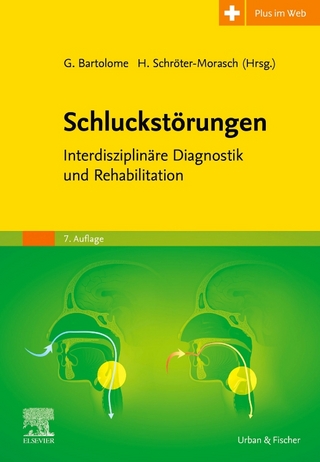
Voice Disorders
Plural Publishing Inc (Verlag)
978-1-63550-251-0 (ISBN)
With Voice Disorders, Fourth Edition, authors Christine Sapienza, PhD and Bari Hoffman, PhD have created a comprehensive package for learning. The authors uniquely blend voice science with voice treatments ranging from traditional interventions to recent advances in cellular therapies, muscle strength training, and treatments for special populations. The text has been extensively updated with clinical evidence-based information and comes with a robust online companion website including a study workbook, videos, audio files, and case studies.
This fourth edition offers a comprehensive combined study of the respiratory, laryngeal, and neurological subsystems for voice. Therapy approaches are categorized in terms of type, such as physiologic, combined modality, and hygienic. The new edition expands the approaches to voice therapy, and better defines clinical decision making with information about humanistic communication strategies, adherence, and the multitude of variables that influence patient outcomes.
New to the Fourth Edition:
*The anatomical illustrations are now in color!
*Updated throughout to reflect the current state of research in the evaluation and treatment of voice and upper airway disorders
*Many new references depicting evidence-based outcomes
*Updated clinical guidelines and position statements
*A thoroughly revised chapter on voice therapy
*Extensive content added on gender affirmation: the role of the SLP along with various evaluation and therapy approaches
*More laryngeal images and endoscopic examinations
*Expanded coverage of contemporary phonosurgery approaches and the role of the SLP pre- and post-surgery
*Extensively expanded material on head and neck cancer and alaryngeal communication
Christine Sapienza, PhD, CCC-SLP, serves as the Dean of the Jacksonville University, Brooks Rehabilitation College of Healthcare Sciences. Previously, Dr. Sapienza was a longstanding tenured professor and chair of the Department of Communication Sciences and Disorders at the University of Florida, as well as a research career scientist at the Brain Rehabilitation Research Center at the Malcom Randall Veterans Administration Hospital. As a principal investigator of National Institutes of Health grants, VA Research Rehabilitation Research and Development Awards, and a M.J. Fox Foundation grant, Dr. Sapienza has provided extensive mentoring to 16 doctoral students, all of whom have contributed back to academics and clinical service. She has built a strong national and international reputation for expertise in the design and implementation of larger scale randomized clinical trials examining treatments as well as the careful reporting of peer-reviewed outcomes from these studies. Dr. Sapienza methodically disseminates this information to the scientific community at large in the form of invited presentations, workshops, and clinical teaching platforms. Through writing, she works to integrate research findings in journal articles, textbooks, and clinical manuals. As a frequent contributor to patient support groups she aspires to assist patients and caregivers as they navigate available treatments and emerging science. Most recently, Dr. Sapienza was selected as Jacksonville's Women of Influence.+++++++++++++++++++++++++++++++++++++++++++++Bari Hoffman, PhD, CCC-SLP, is an Associate Professor in the Department of Communication Sciences and Disorders and jointly appointed as Associate Professor, Internal Medicine at the University of Central Florida. Dr. Hoffman serves as research partner to the Florida Hospital Cancer Institute and Director of the Center for Voice Care and Swallowing Disorders at the Ear Nose Throat and Plastic Surgery Associates. She has worked clinically in this setting for more than 18 years treating individuals with voice and upper airway disorders specializing in pediatric, professional and neurogenic populations, along with individuals undergoing treatment for head and neck cancer. Dr. Hoffman received her doctoral degree from the University of Florida in 2001. Her current research involves studying novel treatment technologies and biomechanical mechanisms for disorders of laryngeal function while defining the high impact on quality of life factors. She implements 3-D computer modeling of upper and lower airway function, coping strategies of individuals with dysphonia and respiratory muscle strength paradigms in a variety of patient groups. Dr. Hoffman has a significant record of peer-reviewed publications, authorship of multiple textbooks, and actively lectures across the country on these topics. In recognition of her contributions to teaching, research, and service, she has received numerous awards within her University and state association.
Foreword by Thomas Murry, PhD
Preface
Acknowledgments
Contributors
Companion Website
Chapter 1. Respiratory Anatomy and Physiology
The Lungs
The Trachea
The Bronchi
The Thorax
The Ribs
The Diaphragm
The Abdominal Wall
Sternum
Clavicle
Driving Forces of the Respiratory System
How Does the Human Body Generate These Respiratory Forces?
Passive and Active Forces of the Respiratory System
The Respiratory System and Voice Production
Relaxation Pressure Curve
Using the Right Terminology
Biofeedback Techniques
Summary
References
Chapter 2. Laryngeal Anatomy and Physiology
Laryngeal Anatomy
Laryngeal Structure: Pieces and Parts
Laryngeal Muscles
What Are the Vocal Folds Made of, Exactly?
Laryngeal Ligaments and Membranes
Extrinsic Membranes
Intrinsic Membranes
Ligaments
Aryepiglottic Folds
Cavities
Arterial Supply of the Larynx
Laryngeal Nerve Supply
Laryngeal Development (Infancy to Adulthood)
Adult Male and Female Differences in Laryngeal Anatomy
Age Effects on Laryngeal Anatomy
Phonation
Mechanisms for Changing Pitch
What Is a Vocal Register?
Mechanism for Changing Loudness
Summary
References
Chapter 3. Vocal Health
Phonotrauma
Basic Issues Related to Vocal Health
Recovery Process
Contributors to Poor Vocal Health
Summary
References
Chapter 4. Evaluation
The Specialty of Otolaryngology
Case History
The Physical Examination
Laryngoscopic Techniques
Instrumental Assessment
Imaging
Digital Laryngostroboscopy
Videokymography
Aerodynamics
Classic Methods for Collection of Aerodynamic Signals
Laryngeal Aerodynamic Variations
Laryngeal Aerodynamics as a Function of Aging
Laryngeal Aerodynamic Differences as a Function of Sex
Laryngeal Aerodynamic Changes as a Function of Speech Task
Using Aerodynamics for Examination of Voice Disorders
Acoustic Analysis of Voice
Intensity
Voice Range Profile
Short-Term Perturbation
Relative Noise Level
Spectral Measures
Fast Fourier Transform (FFT)
Vowel Spectrum
Long-Term Average Spectrum
Cepstral Peak
Electroglottography
Electromyography
Auditory-Based Measures of Voice Quality
Indices Obtained by Combining Measurements
Perceptual Rating Scales
Voice Handicap Scales and Quality-of-Life Scales
Voice Handicap Index
Voice-Related Quality-of-Life Scale
Hygiene and Safety of Equipment
Summary
References
Appendix 4-1. Case History Form - Voice
Appendix 4-2. Videostroboscopy Rating Form
Appendix 4-3. Position Statement: Evidence-Based Practice in Communication Disorders
Appendix 4-4. Relevant Paper: The Roles of Otolaryngologists and Speech-Language Pathologists in the Performance and Interpretation of Strobovideolaryngoscopy
Appendix 4-5. Voice Handicap Index
Appendix 4-6. Voice-Related Quality of Life Measure
Appendix 4-7. Recommended Protocols
Chapter 5. Vocal Pathology
Etiology of Voice Disorders
Vocal Lesions
Pathology Classifications
Incidence of Voice Disorders
Structural Pathologies of the Vocal Folds
Vascular Lesions
Functional Voice Disorders
Idiopathic
Autoimmune
Summary
References
Chapter 6. Neurologically Based Voice Disorders
Neurologic Voice Disorders
Other Neurologic Cases
Summary
References
Chapter 7. Vocal Rehabilitation
Addressing Patient Diversity in Vocal Rehabilitation
Clinical Competence
The Road to Therapy
Communication Strategies
Adherence
Voice Therapy
The Evolving Process of Voice Therapy
Goals of Voice Therapy
Definition of Treatment Efficacy
Voice Therapy Approaches: What Are They?
Specific Treatments for Other Populations
Special Considerations for Gender-Affirming Voice and Communication Therapy
Voice Therapy for School-Age Children With Voice Disorders
Technology and Gaming in Voice Therapy
Biofeedback Techniques
Alternative Voice Management
Defining a Voice Outcome
Criteria for Termination of Therapy
Telehealth Options
Definition of Treatment Effectiveness
Summary
References
Appendix 7-1. Voice Stimuli
Chapter 8. Management: Phonosurgery
Surgical Treatment of Dysphonia
Awake Procedures
General Considerations in the Surgical Approach to the Larynx
Microlaryngoscopy With Nodule Removal
Microflap Dissection
Laser Laryngoscopy
Laryngeal Microdebrider Dissection
Injection Augmentation
Laryngeal Framework Surgery
Selected Clinical Cases
Suggested References for Reading
Appendix 8-1. Postoperative Instructions for Surgery of Vocal Fold Lesions
Chapter 9. Team Management of Head and Neck Cancer
Introduction
Head and Neck Cancer Statistics
Head and Neck Cancer Sites
Head and Neck Cancer Types
Head and Neck Squamous Cell Cancers
General Cancer Staging
Primary Tumor Staging
Cancer Spread
Surgical Options for Treating Head and Neck Cancer
Organ Preservation Through Radiation and Chemotherapy
Combined Management Approaches
Multidisciplinary Clinical and Research Team
Surgical Options for Laryngeal Cancer
The Role of the Speech-Language Pathologist Prior to Laryngectomy
The Role of the Speech-Language Pathologist Following Laryngectomy
Types of Partial Laryngectomy Procedures
Postoperative Strategies
Communication Following Total Laryngectomy
Developing a System to Track Outcomes With the HNC Population
Future Directions
Conclusions
Useful Websites
References
Appendix 9-1. Case Example: Management of SCCA In Situ in a Professional Performer: An Interdisciplinary Approach
Appendix 9-2. Case Example: Management of Recurrent Laryngeal Cancer Spanning 10 Years
Appendix 9-3. Voicing Practice Exercises: Handout for the Laryngectomized Patient
Chapter 10. Vocal Performance
What Constitutes Singing Voice Intervention?
The Singing Voice
The Voice Care Team
Performer Classifications and Vocal Registers
Etiology of Dysphonia in Vocal Performers
Compensatory and Cover Techniques Used by Vocal Performers
Singers and Support
Clinical Assessment of Vocal Performers
The Medical, Social, and Singing History
Speaking Voice Assessment
Vocal Load
Vocal Pacing and Budgeting
Singing Voice Assessment
Training and Techniques Specific to Performance Voice
Case Examples
Singing Health
Professional Associations
Case Studies
Summary
References
Appendix 10-1. Singer's History Form
Appendix 10-2. Singing Voice Handicap Index (S-VHI)
Appendix 10-3. Evaluation of the Ability to Sing Easily (EASE)
Appendix 10-4. Glossary of Singing Terms
Chapter 11. Drug Types and Effects on Voice
Drug Interactions
Patient-Specific Factors
Drug Administration
Drug Classes
Psychoactive Medications
Drug Compliance
Herbal Supplements and Alternative Medicines
Special Populations
Summary
Recommended Readings
References
Appendix 11-1. Chapter 11 Glossary
Chapter 12. Immune System Response to Diseases and Its Impact on Laryngeal Function
Introduction
Innate Immunity and Wound Healing
Adaptive Immunity
Fibroblasts' Immune Functions
Immunologic Barriers to Treatment
Biomaterials
Cell-Based Therapies
Conclusions
References
Chapter 13. Laryngeal Reflexes
Sensory Receptors
Free Nerve-Ending Receptors
Encapsulated Nerve Endings
Pathway of Sensory Information
Laryngeal Reflexes
Upregulation of Sensory Afferents
Down Regulation of Sensory Afferents
References
Glossary
Index
| Erscheinungsdatum | 10.05.2021 |
|---|---|
| Zusatzinfo | 145 figures and 13 tables |
| Verlagsort | San Diego |
| Sprache | englisch |
| Maße | 178 x 254 mm |
| Themenwelt | Medizin / Pharmazie ► Gesundheitsfachberufe ► Logopädie |
| ISBN-10 | 1-63550-251-9 / 1635502519 |
| ISBN-13 | 978-1-63550-251-0 / 9781635502510 |
| Zustand | Neuware |
| Haben Sie eine Frage zum Produkt? |
aus dem Bereich


